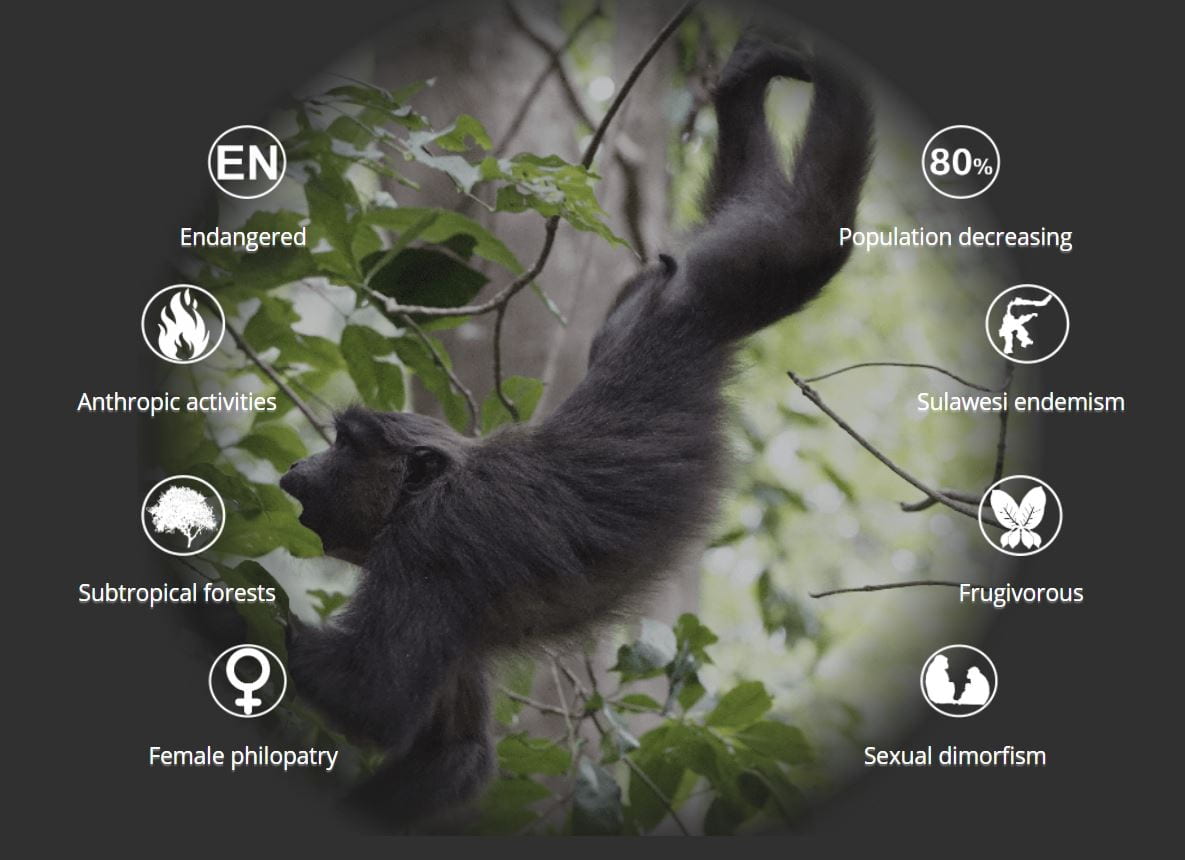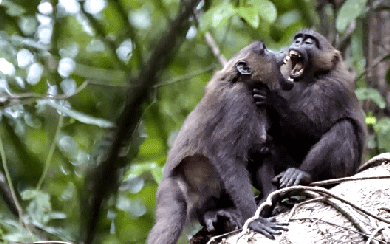MACACA MAURA PROJECT
STUDY SPECIES
Endangered
Population decreasing
Anthropic activities
Sulawesi endemism
Subtropical forests
Frugivorous
Female philopatry
Sexual dimorfism

The moor macaque (Macaca maura) is one of the seven endemic species of macaques living on Sulawesi Island (Indonesia; Riley 2010). Moor macaques are categorized as endangered by the IUCN Red List of Threatened Species (Supriatna et al. 2008). The last population survey was conducted in 1992 and showed a population decrease of 50–80% in less than 10 years, with approximately 10,000 individuals left in the wild (Supriatna et al. 1992). The main threats to this species are habitat destruction, fragmentation and disturbance, which are usually linked to an increase in anthropic pressure (e.g. large human settlements, mining, quarrying, agricultural industrialisation). Other threats include the hunting of macaques for food or as pets (Supriatna et al. 2008).
Moor macaques can be found in the south-western area of Sulawesi in Indonesia. They inhabit subtropical forests, deciduous forests, karst areas and grasslands below 2000 meters of altitude. Home range is around 17-22 ha in the karst forest (Albani et al. 2020). Moor macaques are diurnal and quadrupedal, they are mainly frugivorous but their diet also includes leaves, insects, lizards and fungi (Riley 2010; Albani et al. 2020). They live in multifemale-multimale groups of arround 15-40 individuals, with female philopatry and male dispersal (Okamoto et al. 2000; Riley et al. 2014). Moor macaques have relatively relaxed social relationships between group members, with low frequency of intense aggression (Matsumura 1996; Riley et al. 2014). This species exhibits sexual dimorphism (males: 640-690mm; females: 500-585mm), and its fur colour varies from black/brown to grey or even white (Rowe, 1996). Moor macaques reach sexual maturity at the age of 4-8 years and males emigrate when they are 7-9 years old (Okamoto et al. 2000). The moor macaque has moderate breeding seasonality and female display sexual swellings that last about 12 days (Okamoto et al. 2000). Inter-birth interval is around 32 months and gestation lasts around 174-196 days (Matsumura 1993; Okamoto et al. 2000; Rowe 1996).

Interactions between moor macaques and humans are becoming increasingly frequent in some part of South Sulawesi, due to habitat loss and increased human population (Supriatna et al. 2008). The frequency and nature of such interactions is carefully monitored for conservation purposes, as human activity can affect the behaviour and ecology of moor macaques (Albani et al. 2019; Morrow et al. 2019). However, the intensity of conflict between local populations and macaques is usually low, as farmers are often tolerant towards the macaques (Riley & Priston 2010).
Albani, A., De Liberato, C., Wahid, I., Berrilli, F., Riley, E. P., Cardeti, G., Ngakan, P. O., & Carosi, M. (2019). Preliminary assessment of gastrointestinal parasites in two wild groups of endangered moor macaques (Macaca maura) from Sulawesi. International Journal of Primatology, 40(6), 671-686.
Albani, A., Cutini, M., Germani, L., Riley, E. P., Ngakan, P. O., & Carosi, M. (2020). Activity budget, home range, and habitat use of moor macaques (Macaca maura) in the karst forest of South Sulawesi, Indonesia. Primates, 1-12.
Matsumura (1993). Female reproductive cycles and sexual behavior of moor macaques (Macaca maurus) in their natural habitat, South Sulawesi, Indonesia. Primates 34(1) 99-103
Matsumura, S. (1996). Postconflict affiliative contacts between former opponents among wild moor macaques (Macaca maurus). American Journal of Primatology, 38(3), 211-219.
Mittermeier, R. A., Wilson, D. E., & Rylands, A. B. (Eds.). (2013). Handbook of the mammals of the world: primates. Lynx Edicions.
Morrow, K. S., Glanz, H., Ngakan, P. O., & Riley, E. P. (2019). Interactions with humans are jointly influenced by life history stage and social network factors and reduce group cohesion in moor macaques (Macaca maura). Scientific Reports, 9(1), 1-12.
Okamoto, K., Matsumura, S., & Watanabe, K. (2000). Life history and demography of wild moor macaques (Macaca maurus): Summary of ten years of observations. American Journal of Primatology, 52(1), 1–11.
Riley, E. P. (2010). The endemic seven: Four decades of research on the Sulawesi macaques. Evolutionary Anthropology, 19(1), 22-36.
Riley, E. P., & Fuentes, A. (2011). Conserving social–ecological systems in Indonesia: Human–nonhuman primate interconnections in Bali and Sulawesi. American Journal of Primatology, 73(1), 62-74.
Riley, E. P., & Priston, N. E. (2010). Macaques in farms and folklore: exploring the human–nonhuman primate interface in Sulawesi, Indonesia. American Journal of Primatology, 72(10), 848-854.
Riley, E. P., Sagnotti, C., Carosi, M., & Oka, N. P. (2014). Socially tolerant relationships among wild male moor macaques (Macaca maura). Behaviour, 151(7), 1021-1044.
Supriatna, J., Froehlich, J. W., Erwin, J., & Southwick, C. (1992). Population, habitat and conservation status of Macaca maurus, Macaca tonkeana and their putative hybrids. Tropical Biodiversity, 1(1), 31–48.
Supriatna, J., Shekelle, M. & Burton, J. (2008) Macaca maura. The IUCN Red List of Threatened Species 2008: e.T12553A3356200. http://dx.doi.org/10.2305/IUCN.UK.2008.RLTS.T12553A3356200.en.
MACACA MAURA PROJECT
STUDY SPECIES
The moor macaque (Macaca maura) is one of the seven endemic species of macaques living on Sulawesi Island (Indonesia; Riley 2010). Moor macaques are categorized as endangered by the IUCN Red List of Threatened Species (Supriatna et al. 2008). The last population survey was conducted in 1992 and showed a population decrease of 50–80% in less than 10 years, with approximately 10,000 individuals left in the wild (Supriatna et al. 1992). The main threats to this species are habitat destruction, fragmentation and disturbance, which are usually linked to an increase in anthropic pressure (e.g. large human settlements, mining, quarrying, agricultural industrialisation). Other threats include the hunting of macaques for food or as pets (Supriatna et al. 2008).

Moor macaques can be found in the south-western area of Sulawesi in Indonesia. They inhabit subtropical forests, deciduous forests, karst areas and grasslands below 2000 meters of altitude. Home range is around 17-22 ha in the karst forest (Albani et al. 2020). Moor macaques are diurnal and quadrupedal, they are mainly frugivorous but their diet also includes leaves, insects, lizards and fungi (Riley 2010; Albani et al. 2020). They live in multifemale-multimale groups of arround 15-40 individuals, with female philopatry and male dispersal (Okamoto et al. 2000; Riley et al. 2014). Moor macaques have relatively relaxed social relationships between group members, with low frequency of intense aggression (Matsumura 1996; Riley et al. 2014). This species exhibits sexual dimorphism (males: 640-690mm; females: 500-585mm), and its fur colour varies from black/brown to grey or even white (Rowe, 1996). Moor macaques reach sexual maturity at the age of 4-8 years and males emigrate when they are 7-9 years old (Okamoto et al. 2000). The moor macaque has moderate breeding seasonality and female display sexual swellings that last about 12 days (Okamoto et al. 2000). Inter-birth interval is around 32 months and gestation lasts around 174-196 days (Matsumura 1993; Okamoto et al. 2000; Rowe 1996).

Interactions between moor macaques and humans are becoming increasingly frequent in some part of South Sulawesi, due to habitat loss and increased human population (Supriatna et al. 2008). The frequency and nature of such interactions is carefully monitored for conservation purposes, as human activity can affect the behaviour and ecology of moor macaques (Albani et al. 2019; Morrow et al. 2019). However, the intensity of conflict between local populations and macaques is usually low, as farmers are often tolerant towards the macaques (Riley & Priston 2010).
Albani, A., De Liberato, C., Wahid, I., Berrilli, F., Riley, E. P., Cardeti, G., Ngakan, P. O., & Carosi, M. (2019). Preliminary assessment of gastrointestinal parasites in two wild groups of endangered moor macaques (Macaca maura) from Sulawesi. Int. J. Primatol, 40(6), 671-686.
Albani, A., Cutini, M., Germani, L., Riley, E. P., Ngakan, P. O., & Carosi, M. (2020). Activity budget, home range, and habitat use of moor macaques (Macaca maura) in the karst forest of South Sulawesi, Indonesia. Primates, 1-12.
Matsumura (1993). Female reproductive cycles and sexual behavior of moor macaques (Macaca maurus) in their natural habitat, South Sulawesi, Indonesia. Primates 34(1) 99-103
Matsumura, S. (1996). Postconflict affiliative contacts between former opponents among wild moor macaques (Macaca maurus). Am. J. Primatol, 38(3), 211-219.
Mittermeier, R. A., Wilson, D. E., & Rylands, A. B. (Eds.). (2013). Handbook of the mammals of the world: primates. Lynx Edicions.
Morrow, K. S., Glanz, H., Ngakan, P. O., & Riley, E. P. (2019). Interactions with humans are jointly influenced by life history stage and social network factors and reduce group cohesion in moor macaques (Macaca maura). Sci. Rep., 9(1), 1-12.
Okamoto, K., Matsumura, S., & Watanabe, K. (2000). Life history and demography of wild moor macaques (Macaca maurus): Summary of ten years of observations. Am. J. Primatol, , 52(1), 1–11.
Riley, E. P. (2010). The endemic seven: Four decades of research on the Sulawesi macaques. Evolutionary Anthropology, 19(1), 22-36.
Riley, E. P., & Fuentes, A. (2011). Conserving social–ecological systems in Indonesia: Human–nonhuman primate interconnections in Bali and Sulawesi. Am. J. Primatol, , 73(1), 62-74.
Riley, E. P., & Priston, N. E. (2010). Macaques in farms and folklore: exploring the human–nonhuman primate interface in Sulawesi, Indonesia. Am. J. Primatol, , 72(10), 848-854.
Riley, E. P., Sagnotti, C., Carosi, M., & Oka, N. P. (2014). Socially tolerant relationships among wild male moor macaques (Macaca maura). Behaviour, 151(7), 1021-1044.
Supriatna, J., Froehlich, J. W., Erwin, J., & Southwick, C. (1992). Population, habitat and conservation status of Macaca maurus, Macaca tonkeana and their putative hybrids. Tropical Biodiversity, 1(1), 31–48.
Supriatna, J., Shekelle, M. & Burton, J. (2008) Macaca maura. The IUCN Red List of Threatened Species 2008: e.T12553A3356200. http://dx.doi.org/10.2305/IUCN.UK.2008.RLTS.T12553A3356200.en.
MACACA MAURA PROJECT
STUDY SPECIES
The moor macaque (Macaca maura) is one of the seven endemic species of macaques living on Sulawesi Island (Indonesia; Riley 2010). Moor macaques are categorized as endangered by the IUCN Red List of Threatened Species (Supriatna et al. 2008). The last population survey was conducted in 1992 and showed a population decrease of 50–80% in less than 10 years, with approximately 10,000 individuals left in the wild (Supriatna et al. 1992). The main threats to this species are habitat destruction, fragmentation and disturbance, which are usually linked to an increase in anthropic pressure (e.g. large human settlements, mining, quarrying, agricultural industrialisation). Other threats include the hunting of macaques for food or as pets (Supriatna et al. 2008).

Moor macaques can be found in the south-western area of Sulawesi in Indonesia. They inhabit subtropical forests, deciduous forests, karst areas and grasslands below 2000 meters of altitude. Home range is around 17-22 ha in the karst forest (Albani et al. 2020). Moor macaques are diurnal and quadrupedal, they are mainly frugivorous but their diet also includes leaves, insects, lizards and fungi (Riley 2010; Albani et al. 2020). They live in multifemale-multimale groups of arround 15-40 individuals, with female philopatry and male dispersal (Okamoto et al. 2000; Riley et al. 2014).

Moor macaques have relatively relaxed social relationships between group members, with low frequency of intense aggression (Matsumura 1996; Riley et al. 2014). This species exhibits sexual dimorphism (males: 640-690mm; females: 500-585mm), and its fur colour varies from black/brown to grey or even white (Rowe, 1996). Moor macaques reach sexual maturity at the age of 4-8 years and males emigrate when they are 7-9 years old (Okamoto et al. 2000). The moor macaque has moderate breeding seasonality and female display sexual swellings that last about 12 days (Okamoto et al. 2000). Inter-birth interval is around 32 months and gestation lasts around 174-196 days (Matsumura 1993; Okamoto et al. 2000; Rowe 1996).

Interactions between moor macaques and humans are becoming increasingly frequent in some part of South Sulawesi, due to habitat loss and increased human population (Supriatna et al. 2008). The frequency and nature of such interactions is carefully monitored for conservation purposes, as human activity can affect the behaviour and ecology of moor macaques (Albani et al. 2019; Morrow et al. 2019). However, the intensity of conflict between local populations and macaques is usually low, as farmers are often tolerant towards the macaques (Riley & Priston 2010).




